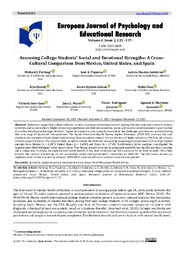Por favor, use este identificador para citar o enlazar este ítem:
https://hdl.handle.net/11000/36096Registro completo de metadatos
| Campo DC | Valor | Lengua/Idioma |
|---|---|---|
| dc.contributor.author | Furlong, Michael | - |
| dc.contributor.author | Piqueras, Jose A | - |
| dc.contributor.author | Chacón-Gutiérrez, Leticia | - |
| dc.contributor.author | Dowdy, Erin | - |
| dc.contributor.author | Nylund-Gibson, Karen | - |
| dc.contributor.author | Chan, Meiki Maggie | - |
| dc.contributor.author | Soto-Sanz, Victoria | - |
| dc.contributor.author | Marzo Campos, Juan Carlos | - |
| dc.contributor.author | Rodríguez-Jiménez, Tíscar | - |
| dc.contributor.author | MARTINEZ-GONZALEZ, AGUSTIN ERNESTO | - |
| dc.contributor.other | Departamentos de la UMH::Psicología de la Salud | es_ES |
| dc.date.accessioned | 2025-03-24T16:16:21Z | - |
| dc.date.available | 2025-03-24T16:16:21Z | - |
| dc.date.created | 2021-12-15 | - |
| dc.identifier.citation | European Journal of Psychology and Educational Research. 2021, 4(2): 123-137 | es_ES |
| dc.identifier.issn | 2589-949X | - |
| dc.identifier.uri | https://hdl.handle.net/11000/36096 | - |
| dc.description.abstract | Endeavors supporting college students’ positive psychosocial development are gaining attention and investment in various countries and social contexts. Higher education experiences provide new academic, social, and vocational advancement opportunities at a critical developmental stage. However, higher education can also cause distress due to the challenges and stressors present during this new stage of increased independence. The Social Emotional Health Survey-Higher Education (SEHS-HE) assesses the core psychosocial strengths of individuals transitioning from secondary schools into institutions of higher education (IHE) to aid campus student support services. The present study sought to extend the SEHS-HE research by examining its application with college student samples from Mexico (n = 4,207), United States (n = 1,638), and Spain (n = 1,734). Confirmatory factor analyses investigated the hypothesized SEHS-HE higher-order factor model. The Mexico sample returned an acceptable model fit, but the USA and Spain samples had a suboptimal fit; hence, we explored alternative models. A two-level structure had full invariance for all three samples. This study extends the current scholarship on the conceptual model and psychometric properties of SEHS-HE. The discussion focuses on implications for future research to enhance SEHS-HE in national and cross-national research and practice. | es_ES |
| dc.format | application/pdf | es_ES |
| dc.format.extent | 15 | es_ES |
| dc.language.iso | eng | es_ES |
| dc.publisher | Eurasian Society of Educational Research | es_ES |
| dc.rights | info:eu-repo/semantics/openAccess | es_ES |
| dc.rights | Attribution-NonCommercial-NoDerivatives 4.0 Internacional | * |
| dc.rights.uri | http://creativecommons.org/licenses/by-nc-nd/4.0/ | * |
| dc.subject | Covitality | es_ES |
| dc.subject | higher education | es_ES |
| dc.subject | measurement invariance | es_ES |
| dc.subject | Social Emotional Health Survey | es_ES |
| dc.subject.other | CDU::1 - Filosofía y psicología::159.9 - Psicología | es_ES |
| dc.title | Assessing College Students’ Social and Emotional Strengths: A CrossCultural Comparison from Mexico, United States, and Spain | es_ES |
| dc.type | info:eu-repo/semantics/article | es_ES |
| dc.relation.publisherversion | https://doi.org/10.12973/ejper.4.2.123 | es_ES |

Ver/Abrir:
2021_EJPER_4_2_123.pdf
446,17 kB
Adobe PDF
Compartir:
 La licencia se describe como: Atribución-NonComercial-NoDerivada 4.0 Internacional.
La licencia se describe como: Atribución-NonComercial-NoDerivada 4.0 Internacional.
.png)